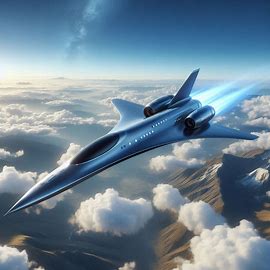
Introduction
Hypersonic jets represent a technological leap that could redefine the future of aerial warfare. Traveling at speeds of Mach 5 and beyond, these aircraft promise unprecedented reach, speed, and lethality. While the development of hypersonic flight dates back decades, today’s advancements bring us closer to operational systems that could dominate future combat zones. This article dives deep into what hypersonic jets are, their advantages, technological challenges, and their role in the next generation of military airpower.
1. Understanding Hypersonic Flight
1.1 What Are Hypersonic Jets?
Hypersonic jets are aircraft or missile systems that travel at speeds greater than Mach 5 (over 3,800 mph). Unlike traditional supersonic jets, hypersonic platforms face extreme heat and require advanced propulsion and material technologies.
Speed Classifications:
- Subsonic: < Mach 1 (e.g., commercial airliners)
- Supersonic: Mach 1–5 (e.g., F-22 Raptor)
- Hypersonic: > Mach 5 (e.g., conceptual SR-72, Chinese WZ-8)
Hypersonic jets often utilize scramjets (supersonic combustion ramjets) or rocket-based combined cycle engines to maintain these speeds in atmospheric flight.
1.2 Historical Roots and Development
The pursuit of hypersonic flight is not new. The X-15 rocket plane in the 1960s achieved speeds over Mach 6, and numerous NASA and military programs have explored hypersonic technologies since then.
Historical Milestones:
- X-15 Program: First crewed hypersonic aircraft
- Space Shuttle: Hypersonic during re-entry
- DARPA’s HTV-2: Experimental hypersonic glide vehicle
These early projects laid the foundation for today’s military and aerospace ambitions.
2. Key Technologies Enabling Hypersonic Jets
2.1 Propulsion Systems
Achieving and sustaining hypersonic speeds requires breakthrough propulsion systems.
Key Types:
- Scramjet Engines: Air-breathing engines that combust fuel in supersonic airflow
- Dual-Mode Ramjets: Transition from subsonic to hypersonic speeds
- Rocket Engines: Used for boost and high-altitude operations
These systems must withstand high thermal loads while maintaining efficiency.
2.2 Heat-Resistant Materials
At hypersonic speeds, aerodynamic friction generates extreme temperatures.
Material Requirements:
- Thermal Barrier Coatings for engine and skin protection
- Ceramic Matrix Composites (CMCs) for lightweight durability
- High-temperature alloys like Inconel and titanium composites
Developing materials that can survive and function under these conditions is one of the greatest engineering challenges.
3. Military Applications and Strategic Value
3.1 Hypersonic Aircraft in Combat Roles
Hypersonic jets offer several tactical advantages in military operations.
Combat Potential:
- Strike capability: Reach distant targets before detection
- Survivability: Speed reduces vulnerability to missile defenses
- Reconnaissance: Near-instantaneous intelligence gathering
Aircraft like the proposed SR-72, dubbed the “Son of Blackbird,” aim to fill these roles.
3.2 Hypersonic Missiles vs. Hypersonic Jets
While hypersonic missiles are already being tested and deployed, hypersonic jets are still in development.
Comparison Table:
| Feature | Hypersonic Jets | Hypersonic Missiles |
|---|---|---|
| Reusability | Yes | No |
| Payload Flexibility | High | Fixed |
| Maneuverability | High (potentially) | Moderate |
| Strategic Use | Surveillance, Strike, ISR | Strike-only |
Both technologies are likely to coexist, serving different strategic purposes.
4. Global Hypersonic Race
4.1 United States: DARPA, NASA, and Lockheed Martin
The U.S. has invested heavily in hypersonic research via multiple agencies.
Notable Projects:
- X-43A and X-51A Waverider (NASA and Air Force)
- SR-72 Project (Lockheed Martin Skunk Works)
- HACM (Hypersonic Attack Cruise Missile) program
Lockheed’s SR-72 aims to fly by the late 2020s, potentially ushering in a new era of air dominance.
4.2 China and Russia’s Hypersonic Progress
Both China and Russia are aggressively pursuing hypersonic platforms.
China:
- WZ-8: Unmanned hypersonic reconnaissance drone
- Starry Sky-2: Experimental wave-rider
Russia:
- Kinzhal (missile): Air-launched hypersonic weapon
- Avangard: Hypersonic glide vehicle
These developments have raised alarms in Western defense circles and accelerated the arms race.
5. Challenges and the Future Outlook
5.1 Technical and Operational Barriers
Despite rapid progress, several hurdles remain:
Challenges:
- Thermal protection systems for sustained hypersonic flight
- Guidance and control at extreme speeds
- Reliable propulsion systems that function in varied altitudes
- Cost and complexity of development and deployment
Solving these will be critical to operationalizing hypersonic jets.
5.2 Civilian and Commercial Possibilities
Though primarily military-focused, hypersonic technology has potential for commercial use.
Future Civil Uses:
- Space tourism with suborbital flight
- Point-to-point travel (e.g., New York to Tokyo in under 2 hours)
- Rapid cargo delivery for high-value goods
Companies like SpaceX, Reaction Engines, and Hermeus are exploring civilian hypersonic transport.
Conclusion: Hypersonic Jets and the Future of Air Warfare
Hypersonic jets are more than futuristic dreams—they are emerging realities with the power to reshape global military strategy. With Mach 5+ speeds, near-instantaneous strike capabilities, and transformative surveillance potential, hypersonic aircraft could become the backbone of 21st-century air combat.
Yet, their deployment depends on solving daunting technical challenges. As countries race toward hypersonic readiness, questions about arms control, defense systems, and ethical use remain.